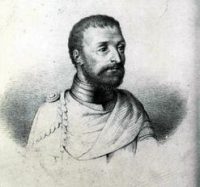[27th October: Heads toward Candighar (Balut Island, Sarangani Municipality, Davao Occidental) and lands in Sarangani Island (now under Sarangani Municipality); takes two pilots who help them reach the Maluku, their ultimate objective.]
[28th October: Leaves the Philippine territory for the Maluku.]
Nos detuvimos allí un día, tomando por fuerza dos pilotos que nos condujeran a las islas Molucas. Según su parecer, corrimos al sud sudoeste, pasando por medio de ocho islas, en parte habitadas y en parte desiertas, que forman una especie de calle. He aquí sus nombres: Cheava, Caviao, Cabiao, Camanuca, Cabaluzao, Cheai, Lipán y Nuza, al fin de las cuales nos encontramos frente a una isla bastante hermosa; pero teniendo el viento contrario, no pudimos jamás doblar la punta, de manera que durante toda la noche nos vimos obligados a dar bordos. En esta ocasión fue cuando los prisioneros que habíamos hecho en Sarangani saltaron del buque y se escaparon a nado con el hermano del rey de Mindanao, aunque después supimos que su hijo, no habiendo podido sostenerse en la espalda de su padre, se había ahogado.
Viendo la imposibilidad de doblar la punta de la isla grande, la pasamos al fin, merced al viento, cerca de varias pequeñas islas. La grande, que se llama Sanghir, está gobernada por cuatro reyes cuyos nombres son: raja Matandatu, raja Laga, raja Bapti y raja Parabu. Se halla situada hacia los 3° 30′ de latitud septentrional, y a veintisiete leguas de Sarangani.
[135] Remaining one day in that harbour, we captured two pilots by force, in order that they might show us the way to Molucca. Then laying our course south-south-west, we passed among eight islands, some inhabited and others not, which were situated in the manner of a street, and their names are Cheava, Caviao, Cabiao, Camanuca, Cabaluzao, Cheai, Lipan, and Nuza; finally, we came to an island at their end, which was very beautiful to look at. As we had a contrary wind, so that we could not double a point of that island, we sailed here and there near it; consequently, one of the men whom we had captured at Saranghai, together with the brother of the king of Magindanao who took with him his small son, escaped during the night by swimming to that island, but the boy was drowned, for he was unable to hold tightly to his father’s shoulders. Being unable to double the said point, we passed below the island, where there were many small islands. That island has four kings, [namely,] Rajah Matandatu, Rajah Lalagha, Rajah Bapti, and Rajah Parabu: they are heathens. The island lies in a latitude of three and one-half degrees toward the Arctic Pole and is twenty-seven leagues from Sarangani; its name is Sanghihe.
[Charts XIV and XV appear here in original.]
Sa aming pamamalagi ng isang araw sa nasabing daungan, puwersahan kaming dumakip ng dalawang piloto, nang sa gayon ay maaari niláng ituro sa amin kung nasaan ang Maluco. Pagkatapos tahakin ang landas patimog timog- kanluran, dumaan kami sa walong may-tao at disyertong isla, na nakaayos na tíla isang lansangan. Chaeua, Cauiao, Cabiao, Camanuca, Cabaluzao, Cheai, Lipan, at Nuza ang mga pangalan nilá. Sa hulí ay sumapit kami sa isang isla sa dulo ng mga ito, na siyáng napakagandang tingnan. Dahil mayroon kaming pasalungat na hangin, kung kayâ hindi kami makaliko sa punto ng naturang isla, naglayag kami paroon at parito malápit dito. Dahil dito, tumakas kinagabihan sa pamamagitan ng paglangoy sa islang iyon ang isa sa mga laláking dinakip namin sa Sarangani, at ang kapatid ng hari ng Magindanao na dinalá ang maliit niyang anak na laláki. Subalit nalunod ang batà, sapagkat hindi niya nagawang kumapit nang maigi sa balikat ng kaniyang ama. Dahil hindi kami makaliko sa nasabing punto, dumaan kami sa ilalim ng isla kung saan maraming maliliit na isla. May apat na hari ang islang iyon, [na siyáng] sina Raia Matandatu, Raia Lalagha, Raia Bapti, at Raia Parabu. Mga pagano ang mga tao. Matatagpuan ang isla sa latitud na tatlo at kalahating digri patúngong Polong Arctico at may layong 27 liga mula sa Sarangani. Sanghir ang ngalan nitó.
